Is managing product data across platforms starting to feel overwhelming? Trying to expand into new markets while managing a vast product catalog?
Choosing the right product information management (PIM) software is essential for growing your online store, all the while maintaining data accuracy, and keeping your team’s workload manageable.
This guide breaks down what to look for in a PIM solution for eCommerce as your business and product catalog expand. We’ll walk you through the main functions of PIM, what to look for in a PIM software, how PIM solves common eCommerce challenges, and how it can help you market your products better, regardless of your industry or business size.
Key takeaways
- A PIM system pulls all your product data together, making sure every channel has accurate, up-to-date information, which is crucial for a smooth customer experience and efficient eCommerce operations.
- When deciding on PIM software, prioritize scalability, integration with existing systems, ease of use, and long-term cost to ensure it supports your company’s growth without piling extra work for your team.
- Top PIM solutions like Akeneo, Pimcore, and inRiver provide strong data management, multichannel support, and customization options; and while at the core they function the same, they differ in features that cater to specific needs.
What is product information management (PIM), and what does it do?
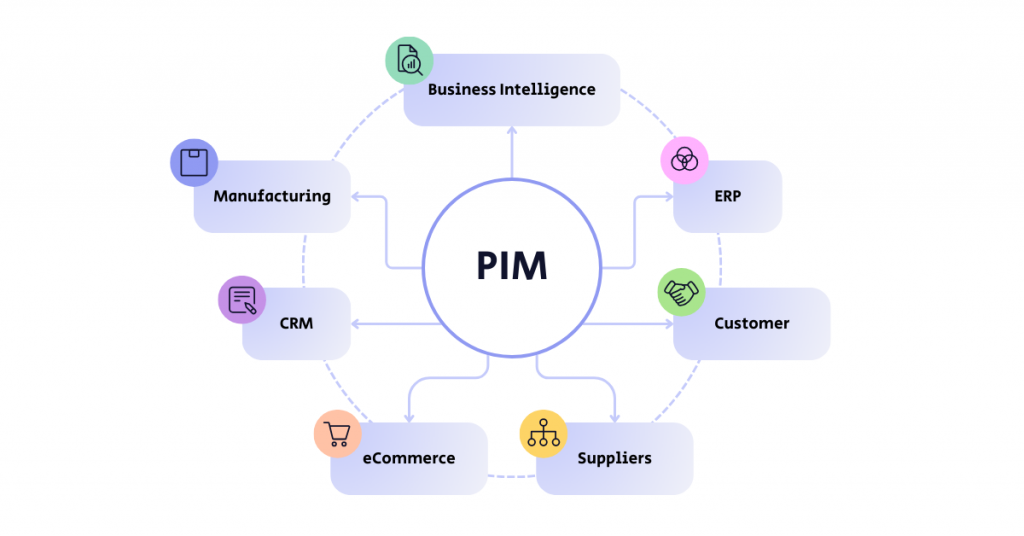
What is a PIM software?
Think of product information management as the central hub for all your product data. A PIM system collects, organizes, and distributes product information across every sales channel, ensuring your data is always accurate and up-to-date. In that way, PIM becomes the “single source of truth” for your product catalog, which is essential for a seamless customer experience and your business operations, too, helping you keep everything consistent, streamline updates, and get products to market faster.
PIM benefits for eCommerce

Using PIM brings significant advantages in eCommerce, operational efficiency, and marketing, including:
- Centralized data management that keeps product catalogs updated and consistent across all platforms
- Faster product launches, reducing time-to-market by up to 60%
- Real-time updates to maintain data quality and avoid outdated information
- Enhanced customer experience with accurate, up-to-date, and personalized product details
- Simplified SKU additions and integration with eCommerce platforms for scalability and growth
- Faster localization, translating product information 70% faster for new markets
- Faster customer quote generation, improving response time by 67%
- Reduced workload for product information managers, enhancing team productivity
- Optimized product data that improves search engine rankings, driving more traffic to your website
With an effective PIM system in place, your business can respond quickly to market demands, operate more efficiently, and stay agile. For a deeper dive into how PIM can benefit your eCommerce setup, download our free PDF guide: PIM and eCommerce integration: What you need to know.
Is PIM the right choice for your business?
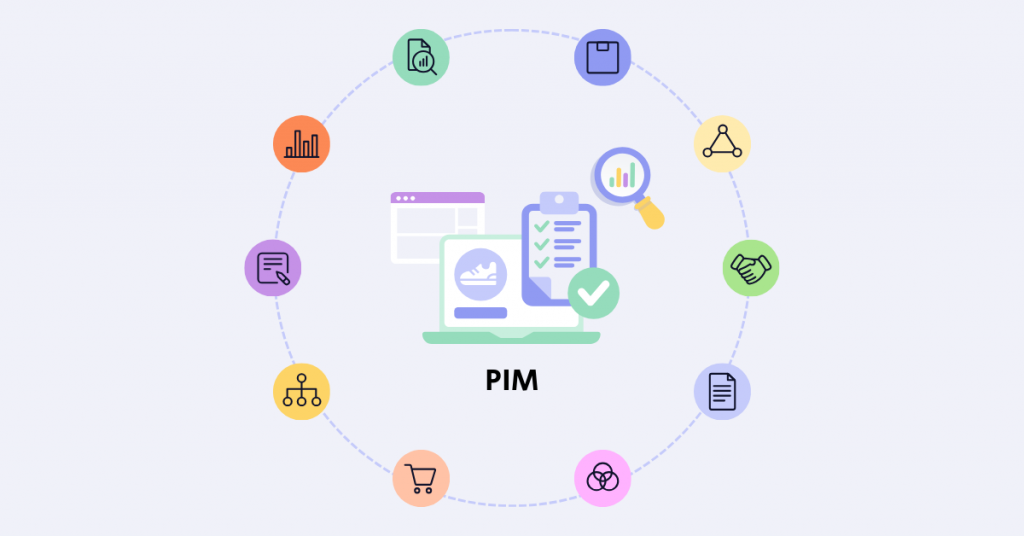
PIM vs. ERP, MDM, CMS, CRM: Understanding the differences
It’s common for companies to think they already have software that does what PIM does. They often mix up PIM with other systems like enterprise resource planning (ERP), master data management (MDM), content management system (CMS), or customer relationship management (CRM).
However, each of these serves a distinct purpose:
- PIM is all about managing and centralizing product-specific data to ensure a consistent customer experience across all sales channels
- ERP primarily manages operational data, such as finance, inventory, and HR, to streamline day-to-day processes
- MDM manages all types of business data (e.g., customer, supplier info) to maintain a unified view across the organization
- CMS organizes website content, such as blogs, articles, and multimedia, making sure everything looks cohesive across digital platforms
- CRM manages customer interactions, tracking sales, customer service, and engagement to strengthen relationships and improve customer service.
A PIM system serves as the backbone of eCommerce operations, connecting various sources of product data—such as CRM, ERP, suppliers, and sales channels—into a single, centralized repository. PIM ensures that product-specific information remains accurate, consistent, and readily accessible across all platforms, from ERP to CRM and CMS.
This integration reduces data duplication, boosts consistency, and keeps everything in sync. As a result, products can be launched faster, business operations are smoother, and customer experience is improved across all channels, driving ROI.
When to consider a PIM system
A PIM system might be just what you need if your business is:
- Struggling with inconsistent product data across platforms
- Handling a high volume of SKUs
- Looking to streamline frequent product updates with real-time data accuracy
- Aiming for a consistent omnichannel experience to enhance customer satisfaction.
PIM features every eCommerce business should consider

Scalable PIM solutions for growing your online store
As your online store expands with new products and markets, a strong PIM should grow with you—without hiccups or slowdowns. Look for PIM solutions that handle increasing SKUs and channels without losing speed or reliability.
Customization with open-source PIM platforms
Open-source PIM platforms like Pimcore and Akeneo give you room to tailor the software exactly to your needs without vendor limitations. If your business has unique requirements or an in-house development team, open-source might be the perfect fit.
For best results, consider partnering with a reliable eCommerce agency that specializes in PIM development and support to ensure every detail is tailored perfectly to your business.
PIM integration capabilities for seamless data flow
A PIM software that has extensive third-party integration options (e.g., Sales Layer, Akeneo) connects seamlessly with ERP, CRM, and eCommerce platforms. This keeps data flowing smoothly across all channels, helping every department stay in sync and up-to-date.
API-centric PIM for real-time updates
If your business needs real-time data sharing across different platforms, look for API-friendly PIMs like Informatica Product 360. This setup lets your PIM communicate easily with other tools, making automated updates and workflows a breeze.
Multi-tenant capabilities for user experience
Multi-tenant PIMs allow multiple users to access and manage data simultaneously, which is a game-changer for global brands. These systems make it easy for teams across various locations to collaborate without compromising on speed or data accuracy.
Pricing: SaaS vs. on-premises PIM options
SaaS PIMs like Salsify ProductXM and Sales Layer are great for businesses looking for easy scalability and minimal maintenance. On-premises solutions offer more control but usually come with higher setup and maintenance costs.
A SaaS solution simplifies cost management by bundling typical expenses—like hosting, licensing, and updates—into a regular subscription fee. However, be aware that implementing PIM is complex and may still incur additional costs depending on specific needs. For example, data migration, complex integrations, or customization efforts can introduce extra fees, particularly if your business has specialized workflows or high data volumes to manage.
Digital Asset Management (DAM) integration for rich media
If your business relies on visuals, choose a PIM with DAM capabilities. This lets you store and organize images, videos, and other media directly within your PIM, creating a consistent brand experience across channels.
Governance and data quality control features
PIMs with governance features let you enforce data quality standards and assign user roles to keep everything consistent. This is especially useful for large-scale operations or businesses in regulated industries, where data accuracy is a must.
Localization and multi-language support
If you’re going global, choose a PIM that supports localization and multi-language capabilities. This feature lets you handle translations, regional pricing, and customized product descriptions, helping your brand resonate with customers worldwide.
Comparison of top PIM solutions in 2024
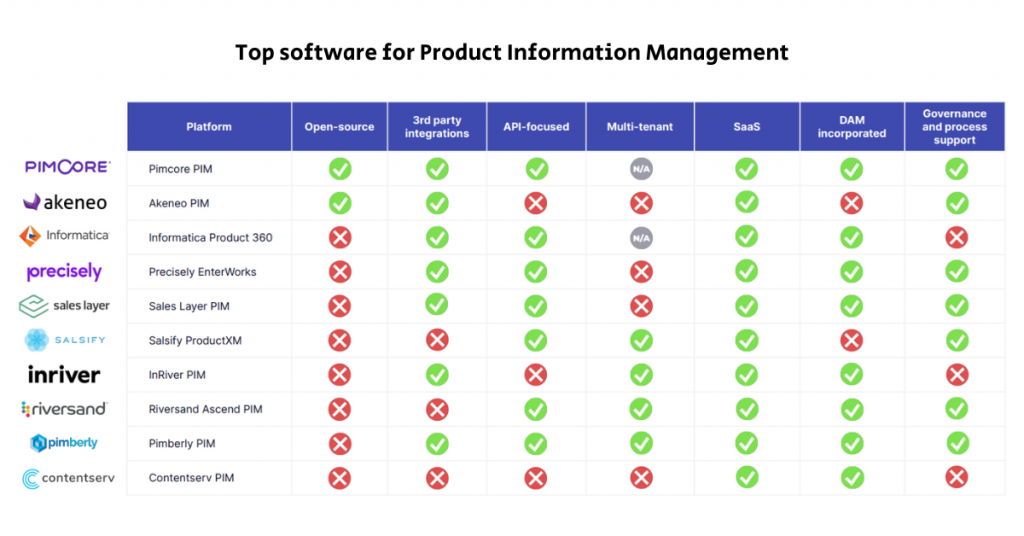
No matter the brand, most product information management systems aim to centralize and simplify product data. However, each software has its own unique features and strengths, like customization, integration options, scalability, and support for specific tools, such as digital asset management (DAM) and multi-tenant setups.
Here’s a quick look at some standout PIM options for different business needs:
- If you need high flexibility, open-source platforms like Pimcore PIM and Akeneo PIM let you customize the software to fit your unique requirements
- For businesses relying on systems like ERP and CRM, Sales Layer PIM and Akeneo offer strong connectivity with third-party tools, ensuring smooth data flow and up-to-date information across platforms
- For businesses that need real-time data sharing, Pimcore PIM and Informatica Product 360 have strong API support, which makes them ideal for synchronizing with other tools across your tech stack
- If you operate across multiple locations or have teams in different regions, Salsify ProductXM and InRiver PIM offer multi-tenant capabilities, making it easy for various teams to access and manage data from one source
- If you’re looking for something low-maintenance and scalable, SaaS-based options like Salsify ProductXM and Sales Layer PIM offer cloud scalability with lower maintenance needs
- If visuals play a big role in your business, consider Pimberly PIM and Contentserv PIM, which come with DAM features, allowing you to store and organize images, videos, and other media directly in the PIM
- For industries with strict regulations, look for strong governance features—Salsify and Akeneo excel in this area.
Step-by-step guide: How to choose the right PIM solution
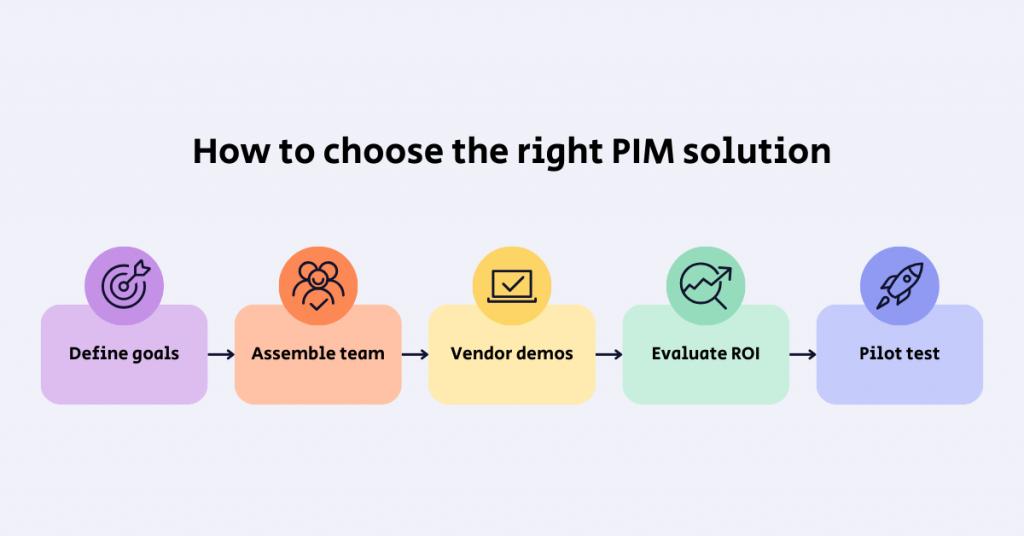
Step 1: Define your eCommerce goals and data requirements
Start by listing out exactly what you want from a PIM system. Clear goals will help guide your choice to fit your business and day-to-day needs. Consider:
- The scale of your product data
- Omnichannel requirements
- The level of customer personalization needed.
Step 2: Assemble your cross-functional team
Get input from all the key departments, such as marketing, sales, IT, and product management. This team will help you identify which features will benefit each area and make it easier to adopt the new PIM across the board.
Step 3: Shortlist PIM vendors and schedule demos
With your goals clear, make a shortlist of PIM vendors that meet your criteria. Feel free to refer to the comparison table in this article, or if you’re still unsure, schedule a free consultation with one of our eCommerce experts.
Request demos to see their tools in action. During a PIM vendor demo, ask questions to dig into specifics, for example:
- How does your PIM handle product information for multiple channels?
- What integrations are available with our current ERP or CRM systems?
- Can it be customized to handle our data in the ways we need?
Step 4: Evaluate ROI and total cost of ownership (TCO)
Look at the costs involved—subscription fees, support, training, and any extras. Compare these costs to the potential ROI, like better data accuracy, faster time-to-market, or improved efficiency, whichever is your business priority. This will help you decide if the investment makes sense.
Step 5: Conduct a pilot or test implementation
Before fully committing, run a test phase. This pilot lets your team experience how the PIM works in a real-world setting. It also reveals any potential issues and confirms that the solution will meet your eCommerce needs.
Common PIM mistakes and how to avoid them
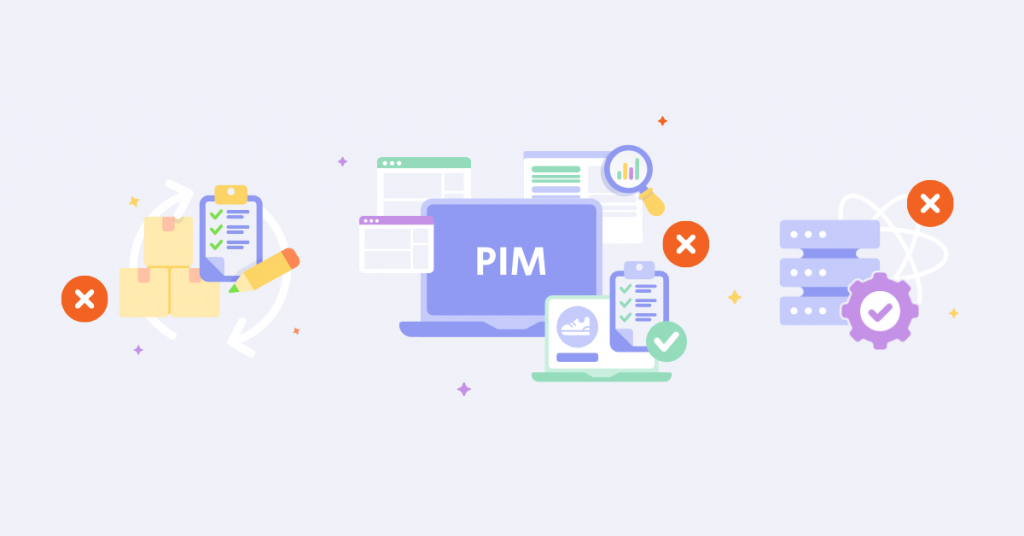
Not prioritizing user training and change management
Implementing a new PIM system without a structured training program and change management plan can lead to significant challenges and frustration. If users aren’t trained or ready for the switch, you’ll likely see low adoption and poor efficiency.
Make sure you have a solid training program in place for everyone who will use the PIM. Clear guidelines and ongoing support can go a long way in making the transition smooth and effective across all teams.
Choosing a “one-size-fits-all” solution
Every business is different, so a generic PIM setup might not work for your unique needs. Look for a PIM platform that offers customization options so you can adjust features to match your industry and business demands. This way, your PIM will support your specific goals rather than just covering the basics.
Ignoring data migration complexities
Moving all your product data into a new PIM can be tricky and time-consuming if not planned properly. Data migration without preparation can lead to incomplete or inconsistent information, which disrupts operations.
Plan ahead by checking data quality, ensuring compatibility of formats, and testing integration with other data sources. A little preparation upfront can make the migration a lot smoother and help avoid issues down the road.
Future-proofing your choice of PIM software for eCommerce

As eCommerce evolves, choosing a PIM that can grow and adapt to your business isn’t just smart; it’s essential.
Here are some key features that make sure your PIM stays relevant and valuable over time—and they’re more than just buzzwords.
Cloud-based PIMs
Cloud-based PIMs offer significant advantages. Because they’re hosted online, you get real-time updates and scalability, making it easy to add new SKUs, access data from any device, and scale without limits. As your product catalog expands, the PIM grows with you, ensuring smooth multichannel access.
Artificial intelligence (AI) and machine learning
Artificial Intelligence isn’t just a trend here; it functions like a smart assistant that makes managing your data easier and faster. AI tools in PIM systems can automate repetitive tasks, like categorizing products or flagging inconsistencies. Plus, machine learning helps you get to know your customers better, allowing for more personalized experiences that keep them engaged.
Product experience management (PXM)
PMX is all about delivering consistent, customized product content. With PXM, you control how your product details appear across every channel, from social media to your eCommerce site, making sure your brand stays cohesive and engaging no matter where customers interact.
Multi-domain support
If you’re managing more than just product data, multi-domain support is worth considering. It lets you handle product, supplier, and customer data all in one place. This centralization saves time and ensures that different teams, like procurement and marketing, work with consistent, up-to-date information.
Composable and headless architectures
Composable and headless architectures let you adapt quickly to new channels and technology changes. Instead of being locked into one system, you get modular components that you can mix and match as needed. It’s like building with LEGO blocks—use only the essential pieces, add new ones when necessary, and stay agile in a fast-evolving digital world.
How to implement PIM for successful eCommerce operations

Implementing a product information management system might seem like a big task, but a clear plan can make it smooth and effective.
Here’s a practical step-by-step guide to getting your PIM up and running:
- Start by auditing your existing product data sources to eliminate inaccuracies and standardize information for consistency
- Identify core PIM features based on business goals, such as data management and multichannel distribution, to choose the right solution
- Connect your PIM with ERP, CRM, eCommerce platforms, and other channels for streamlined data flow across all business tools
- Provide training on PIM functionality and data management workflows to enhance user adoption and efficiency
- Conduct a pilot run, gather feedback, and refine the setup, then optimize for performance before a full launch.
Launching a PIM system can be complex, but doing it right makes a huge difference. Working with experienced PIM experts can simplify the process by providing tailored advice, guiding you through each phase, and helping you optimize the setup for maximum impact on your eCommerce operations.
Case studies: How implementing PIM software drives real results
Still not convinced whether PIM can really make a difference for your business? Take a look at how we helped our clients achieve new heights with tailored PIM solutions.
Technodom: Real-time updates for a successful Black Friday
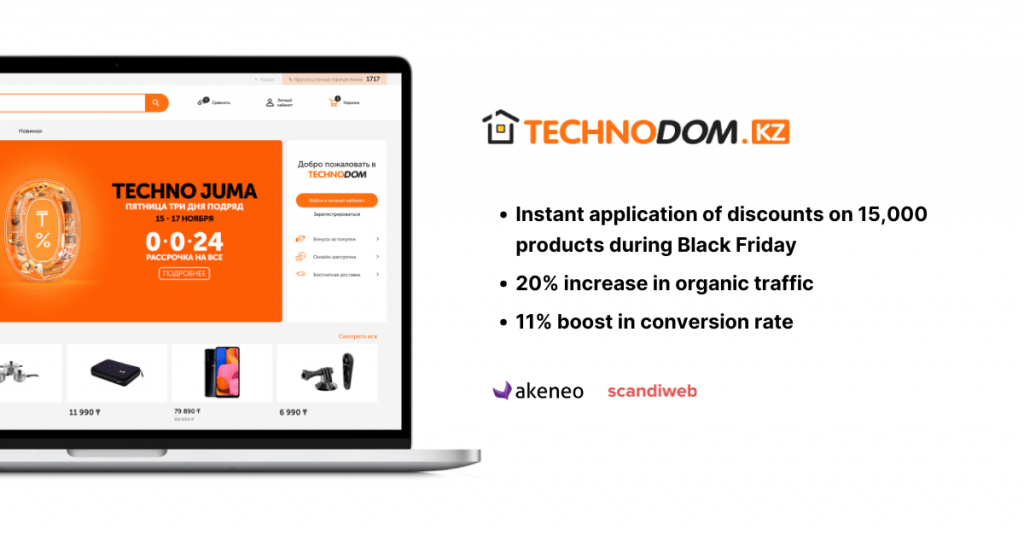
Technodom, a top electronics retailer in Central Asia, needed a way to manage its vast catalog across multiple channels—60,000 products, 15,000 attributes, and 4,000 categories.
Implementing Akeneo PIM enabled Technodom to execute real-time updates, supporting rapid price adjustments across their catalog for time-sensitive sales events like Black Friday. Here’s the result:
- Real-time updates allowed instant application of discounts on 15,000 products during Black Friday
- 20% increase in organic traffic due to improved SEO and data consistency
- 11% boost in conversion rate from enhanced product data accuracy and timeliness.
Byggmax: Building customer trust with reliable stock and pricing
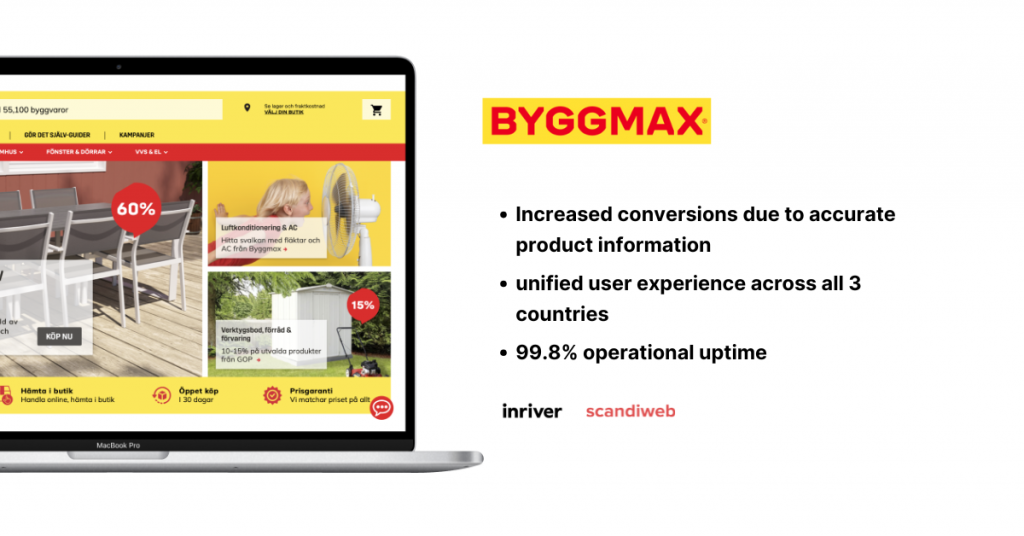
Byggmax, a major DIY retailer with 6 stores in 3 Nordic countries, needed a reliable PIM solution to provide customers with accurate stock and pricing information on their website.
With inRiver PIM, Byggmax ensured customers had real-time access to current product details, improving the overall user experience and driving conversions. Here’s the result:
- Accurate product information led to increased conversions as customers trusted the data they saw
- a unified user experience was achieved across all 3 countries for products, services, and support
- 99.8% operational uptime was achieved, backed by scandiweb’s 24/7 support for reliability across all channels.
Rockar: Pioneering online car sales with custom PIM
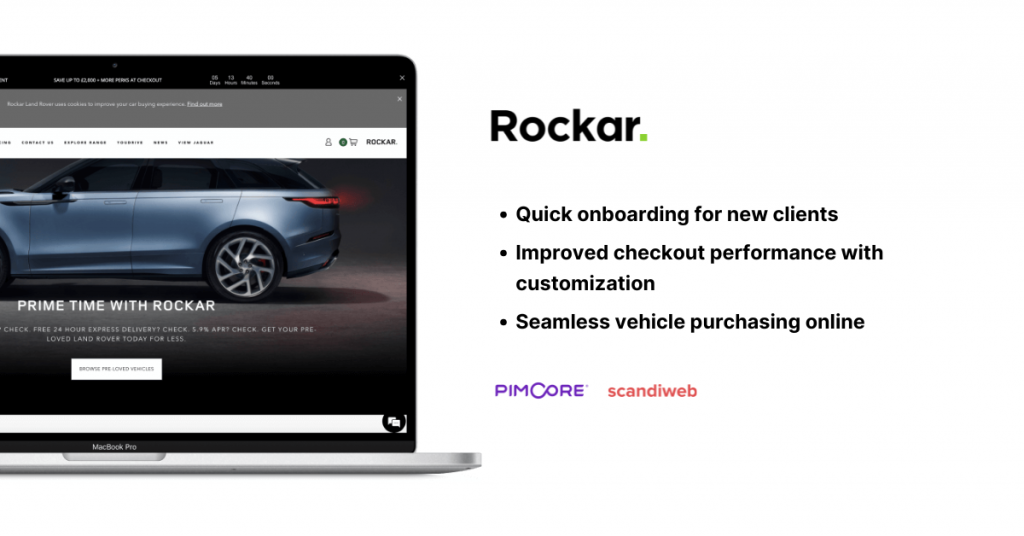
Rockar, an innovator in online car sales, required a way to offer a fully online car purchase journey for both vehicle manufacturers and dealers.
Using scandiweb’s custom Pimcore-based platform allowed Rockar to onboard clients quickly and offer flexible, multi-tenant checkout journeys without the need for multiple code bases. Here’s the result:
- Multi-tenant functionality enabled quick onboarding for new clients on a single code base
- Customizable checkout options improved the user experience for diverse client needs
- Improved platform efficiency supported a seamless online vehicle purchasing process, setting new industry standards.
Conclusion
To wrap it up, choosing the right PIM software can truly transform your eCommerce business. It brings better data management, more consistent customer experiences, and seamless distribution across all your sales channels. By picking a PIM that aligns with your business goals, you’ll be well-positioned to scale, reach new markets, and stay competitive in a fast-evolving industry.
Implementing PIM can get complex, so having expert guidance makes a world of difference. It helps ensure a smooth setup, maximizes your return on investment, and sets you up for long-term success.
Frequently Asked Questions
What is the best PIM software?
Top choices depend on your needs. Akeneo is known for its ease of use and multi-language support. Pimcore is flexible with open-source options, while Salsify excels in integrations for complex workflows.
How much does PIM software cost?
PIM pricing varies widely. Entry-level solutions start around $99/month, while enterprise options can exceed $50,000 annually.
What does a PIM do?
A PIM (product information management) system centralizes, enriches, and syncs product data across sales and marketing channels to keep information consistent and accurate.
Are there hidden costs with PIM software?
Yes, extra fees can include data migration, support, and integrations. Cloud-based (SaaS) options often include maintenance, whereas on-premises setups may add costs for setup and upkeep.
How do you implement PIM?
Start with an audit of your product data to ensure accuracy. Then, define your goals for data consistency and decide which systems (like ERP or CRM) you’ll integrate. Conduct a pilot run to test compatibility, and finally, train your team to manage and update the PIM for a smooth launch. Partnering with experts can streamline the setup and ensure all features work well together.
Not sure which PIM solution is the best fit for managing your product data in your online store? Reach out to us for your personalized consultation on choosing and implementing PIM! Let’s achieve success together!
Explore our popular eCommerce services
About scandiweb
scandiweb is an eCommerce agency specializing in full-service solutions, from web development and digital strategy to PIM implementation. With over 18 years of experience and a team of 500+ experts, scandiweb has empowered companies worldwide to streamline operations, optimize product data, and enhance customer experiences. scandiweb is an award-winning Akeneo partner and is recognized as a Platinum Partner of Pimcore.

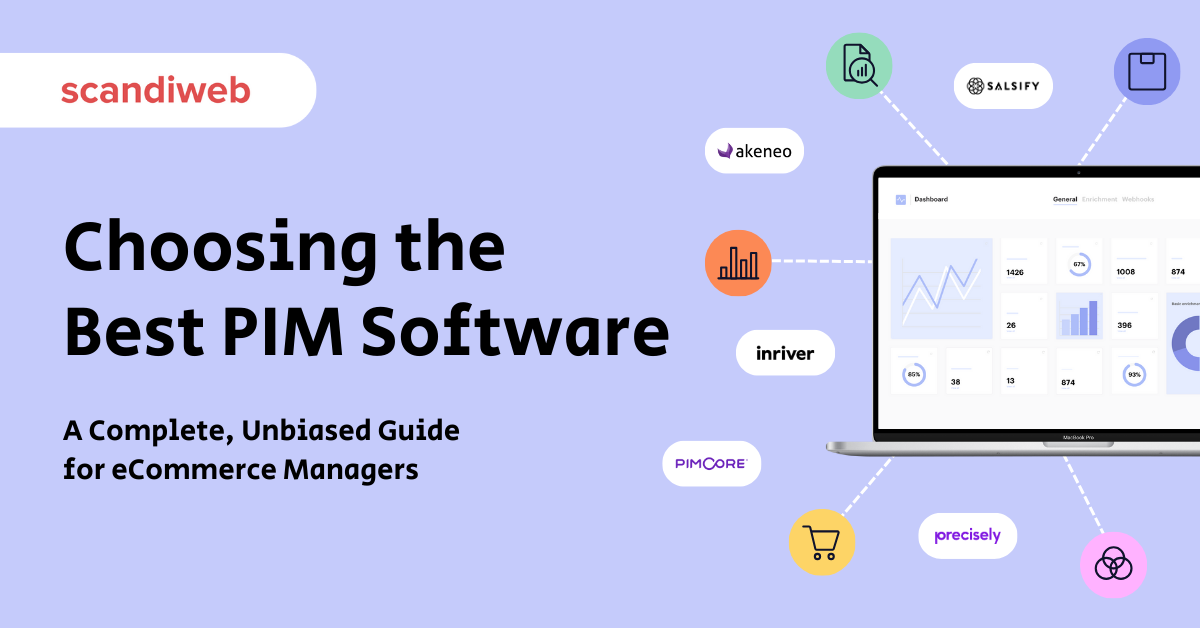
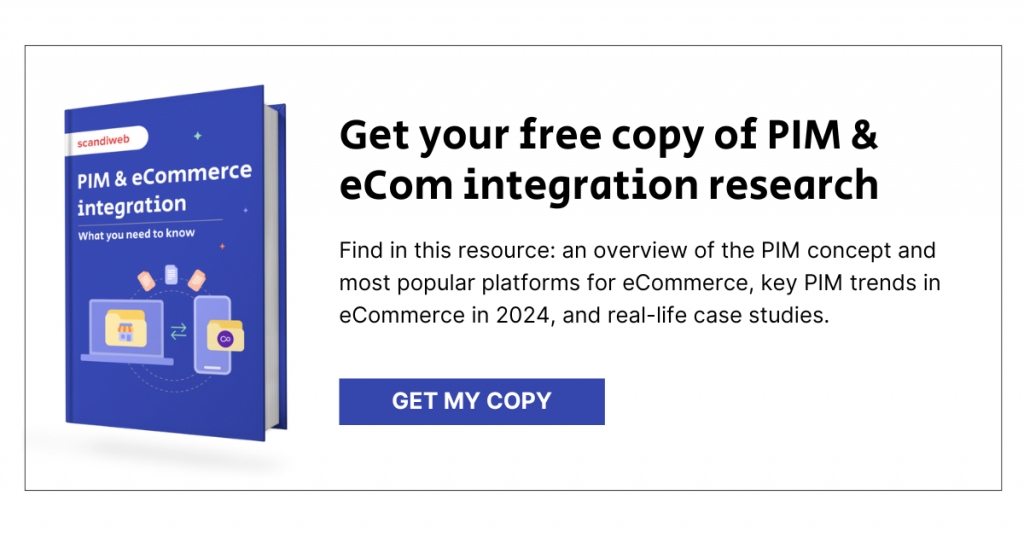
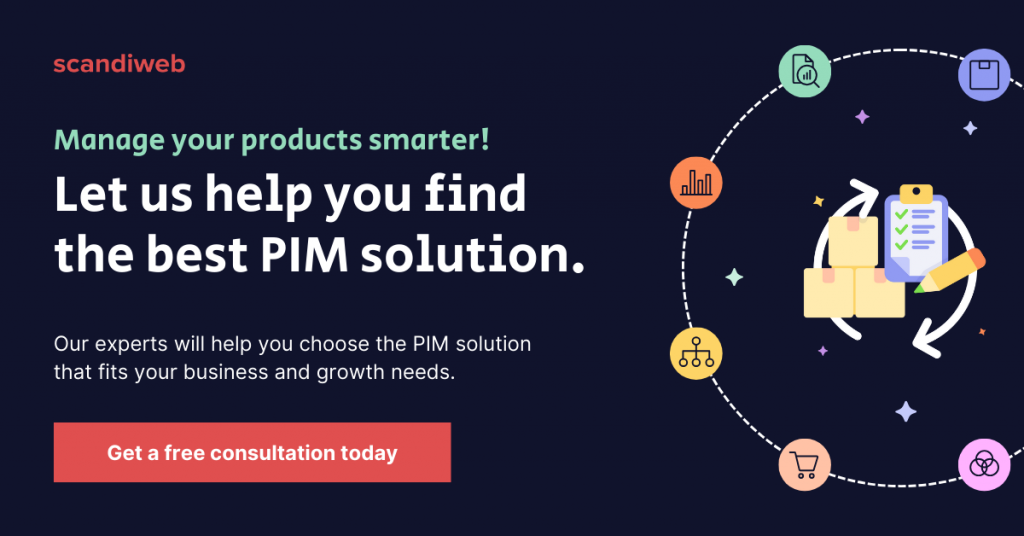

Share on: